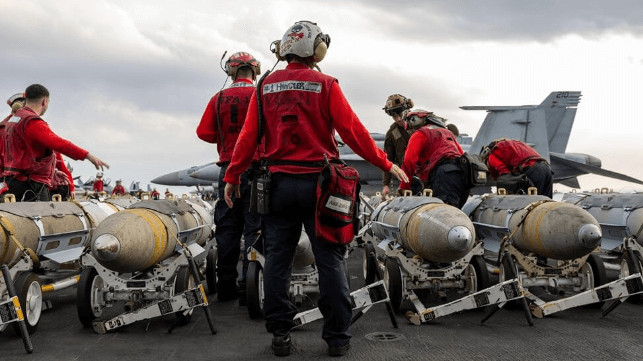U.S. Airstrike Takes Out Houthi Intelligence Chief

Saudi-backed media outlet Al Hadath has reported the death of the Houthi intelligence chief, Abdul Nasser Al-Kamali, in an American airstrike. It is the latest reported fatality among the Houthis' leadership ranks from the intensified U.S. bombing campaign, which is now in its fourth week.
White House National Security Advisor Mike Waltz claimed last week that a U.S. strike took out an unnamed Houthi missile expert, without providing further details. The Pentagon has not confirmed the claim.
“It’s been a bad three weeks for the Houthis, and it’s about to get worse," U.S. Defense Secretary Pete Hegseth said Monday.
The group continues to hit back, albeit at a slower pace than before the airstrike campaign. On Monday, a Houthi spokesman said that the group launched an attack on Tel Aviv with a drone, along with an attempted strike on two U.S. Navy destroyers. The Israeli Defense Force said in a statement that the drone was shot down before it crossed into Israeli airspace, and that no air raid alerts were required.
The Houthis have routinely launched strikes on Israeli and American targets, with limited success; the group has yet to land a confirmed hit on a U.S. Navy vessel, and it only managed to sink two merchant ships in more than 100 attempts in 2024. Both sinkings required repeated follow-up attacks.
Stockpile effects
The cost of the Trump administration's intensified bombing campaign on Yemen is approaching $1 billion, according to the New York Times, raising concerns about the effects on U.S. guided weapons stockpiles. Officials say that Navy pilots have to use standoff weapons to hit Houthi targets, consuming part of the inventory of slow-to-replace advanced munitions.
Over the longer course of the conflict, the steady stream of incoming Houthi drones and missiles has also drained the U.S. Navy's stockpile of advanced interceptors, including the SM-class missiles it needs to shoot down high-end cruise missiles and ballistic missiles. In any future conflict with China, these missiles would be an essential ingredient for the defense of the surface fleet and shoreside installations.
The U.S. Navy's top officer, acting chief of naval operations Adm. James Kilby, said Tuesday that he regrets not pursuing modest laser weapons to take down drone-sized objects. The Navy fielded an anti-drone laser on a deployed warship as early as 2014, but fleetwide use has yet to materialize after 11 years of R&D. In the Red Sea battle environment, the lack of a laser means using up multi-million-dollar missiles on $2,000 inbound drones. Destroyer crews have used up about 200 SM-class missiles defending themselves and nearby shipping from Houthi munitions, and Kilby told Fox that the lack of "better ways to more economically attrit the threat" was a problem.
Under Adm. Kilby's watch as the former deputy commander of Fleet Forces Command, the Navy tried to develop exquisite high-end lasers in the range of 0.5 to 1.0 megawatts, "and I have regret for that," Kilby told Fox. He said that the Navy is hard at work now on low-cost ways to counter autonomous threats, and he called on munitions manufacturers to speed up production.
